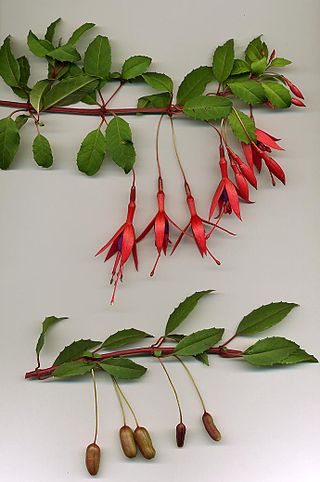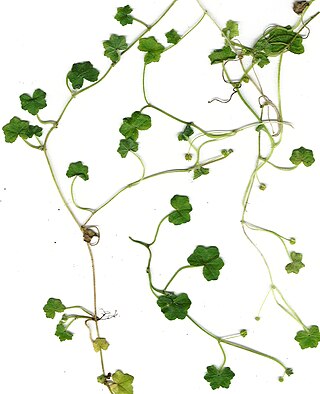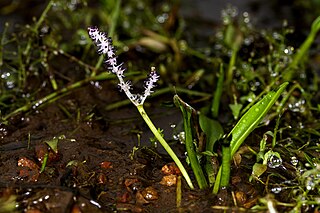
Umbilicus rupestris, the navelwort, penny-pies or wall pennywort, is a fleshy, perennial, edible flowering plant in the stonecrop family Crassulaceae in the genus Umbilicus so named for its umbilicate (navel-like) leaves.

Viburnum acerifolium, the mapleleaf viburnum, maple-leaved arrowwood or dockmackie, is a species of Viburnum, native to eastern North America from southwestern Quebec and Ontario south to northern Florida and eastern Texas. It is adapted for USDA hardiness zones of 4 to 8.

Pennywort is a common name given to several different plants around the world. In general they have round leaves and a low-growing habit. Pennywort may refer to:

Tasmannia lanceolata, commonly known as pepper tree, native pepper, mountain pepper or mountain pepperbush, is a species of flowering plant in the family Winteraceae, and is endemic to south-eastern Australia. It is a dioecious bushy shrub to small tree with lance-shaped or narrowly ellipic leaves, male and female flowers on separate plants, the flowers with 3 to 9 petals, and the fruit a deep maroon to glossy black berry.

Centella asiatica, commonly known as Indian pennywort, Asiatic pennywort, spadeleaf, coinwort or gotu kola, is a herbaceous, perennial plant in the flowering plant family Apiaceae. It is native to tropical regions of Africa, Asia, Australia, and islands in the western Pacific Ocean. It is consumed as a culinary vegetable and is used in traditional medicine.

Fuchsia magellanica – commonly known as the hummingbird fuchsia, hardy fuchsia or chilco – is a species of flowering plant in the evening primrose family Onagraceae, native to the lower Southern Cone of southern South America.

Nepenthes izumiae is a tropical pitcher plant endemic to Sumatra, where it grows in montane forest at 1700–1900 m above sea level. It appears to be most closely related to N. lingulata and N. singalana.

Hydrocotyle, also called floating pennywort, water pennywort, Indian pennywort, dollar weed, marsh penny, thick-leaved pennywort and white rot, is a genus of prostrate, perennial aquatic or semi-aquatic plants formerly classified in the family Apiaceae, now in the family Araliaceae.

Nepenthes lingulata is a tropical pitcher plant endemic to northern Sumatra. The species is characterised by the highly developed appendage present on the underside of the lid. The specific epithet lingulata is derived from the Latin word lingula, meaning "small tongue", and refers to this unique morphological feature.

Macrozamia glaucophylla is a species of cycad from the genus Macrozamia and the family Zamiaceae. Endemic to New South Wales, Australia, this species has features that resembles palms, although both species are taxonomically quite different. The current population trend of Macrozamia glaucophylla is stable with 2,500 to 10,000 mature individuals. The species are found in several habitats including forest and savanna. Ecologically, Macrozamia glaucophylla lives in terrestrial system, a land-based community of organisms where the biotic and abiotic components interact in the given area.

Pseuderanthemum variabile, commonly known as pastel flower or love flower in its native range, or night and afternoon in the USA, is a small perennial herb in the family Acanthaceae which is native to Australia, Papua New Guinea and New Caledonia. It can be an unwelcome nuisance in orchid nurseries in Australia.

Bossiaea cinerea, commonly known as showy bossiaea, is a species of flowering plant in the family Fabaceae and is endemic to south-eastern Australia. It is an erect or spreading shrub with trowel-shaped, triangular, egg-shaped or lance-shaped leaves with a sharply-pointed tip and golden yellow and red to purplish-brown flowers.

Galium antarcticum, commonly known as Antarctic bedstraw or subantarctic bedstraw, is a species of flowering plant in the coffee family. It has a largely subantarctic range.

Dampiera altissima, commonly known as tall dampiera, is an erect perennial herb of the family Goodeniaceae and is native to Western Australia. It is a perennial herb that generally grows to a height of up to 0.5 m and has flat, green-grey leaves. The leaves are mostly round and are between 8-60 mm long. Dampiera altissima flowers during the winter and spring, unveiling small blue-purple flowers. The herb is a ground cover plant found growing on the sandplains, laterite and sandstone of the southwestern region of Western Australia, most common in the Geraldton area north of Perth. The species is sometimes grown as an ornamental plant and is listed as “not threatened”.

Kunzea leptospermoides, commonly known as Yarra burgan, is a flowering plant in Myrtaceae, the myrtle family, and is endemic to Victoria, Australia. It is an erect shrub or small tree with narrow leaves and white flowers crowded near the ends of the branches in spring.

Hydrocotyle phoenix is a species of annual pennywort and is commonly called fire pennywort. It is only known to grow in south-west Australia, specifically in fire prone habitats; it is unique in this regard as it is the only species of Hydrocotyle known to have a fire adapted life-history. The specific epithet "phoenix" references this fire adapted life history as in Greek mythology, a phoenix experiences rebirth by rising from ashes, much like how this plant rises from the ashes after a wildfire.

Dichosciadium ranunculaceum is a monotypic genus of flowering plants belonging to the family Apiaceae. It is a small, flat perennial1 herb that can grow up to 20 cm wide. The species is commonly referred to as Wreath Pennywort.

Acanthopale laxiflora is a weak shrub growing up to two meters tall with woody stems. It is usually grown as an ornamental plant. It grows primarily in the wet tropical biome.

Diplaspis cordifolia is an endemic Tasmanian herb, known commonly as western mountain-pennywort. It is found in alpine vegetation communities across Tasmania, most commonly in the West and South-western areas.

Aponogeton satarensis is a species of aquatic herb in the family Aponogetonaceae endemic to the northern Western Ghats (Maharashtra) of India. It is sometimes commonly known as the Satara lace plant. In Marathi it is known as "y-tura" (वायतुरा). Another common name is Satara aponogeton.




















